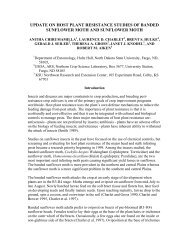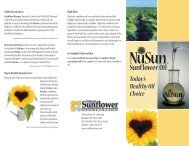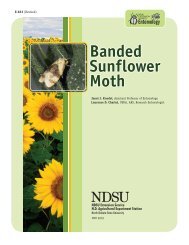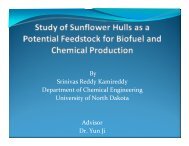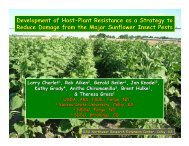Sunflower Production - NDSU Agriculture - North Dakota State ...
Sunflower Production - NDSU Agriculture - North Dakota State ...
Sunflower Production - NDSU Agriculture - North Dakota State ...
You also want an ePaper? Increase the reach of your titles
YUMPU automatically turns print PDFs into web optimized ePapers that Google loves.
Crop Rotation(Greg Endres)Having a proper rotation sequence with all crops,including sunflower, is important. Research shows thatsunflower seed yield is greater following most othercrops than sunflower (Tables 9 and 10).Growers who do not rotate sunflower fields likely willbe confronted with one or more of the following yieldreducingproblems:1. Disease and disease-infested fields2. Increased insect risk3. Increasing populations of certain types of weeds4. Increased populations of volunteer sunflower5. Soil moisture depletion.6. Phytotoxicity or allelopathy of the sunflowerresidue to the sunflower cropTherefore, producers have many valid reasons forrotating sunflower fields.Table 9. Seed yield of sunflower based onprevious crop, Crookston, Minn., 1972-78.PreviousSeed yield/acre (pounds)4-yr.crop 1973 1975 1977 1978 ave.<strong>Sunflower</strong> 852 1,338 1,852 1,781 1,456Potato 908 1,279 2,348 1,605 1,535Sugar beet 770 1,683 2,358 2,168 1,745Pinto bean 946 1,410 2,282 1,674 1,578Wheat 1,284 1,549 2,339 1,655 1,706LSD .05 240 121 292 132Table 10. Seed yield of various crops followingsunflower, Mandan, N.D., 1999-2000.Previous crop<strong>Sunflower</strong>CanolaFlaxSoybeanField peaHRS wheatBarleySeed yield870 lbs/A1,200 lbs/A22.5 bu/A35.2 bu/A41.7 bu/A49.2 bu/A70.0 bu/ARisks of sunflower disease will be greatly magnifiedby short sequencing of sunflower in a crop rotation.Sclerotinia or white mold (wilt, stem rot and head rot)is the primary disease concern with a poor sunflowerrotation. Other disease concerns with improper rotationsinclude Verticillium wilt, Phoma and prematureripening. Rotations of at least three- or four-yearspacings between sunflower or other Sclerotiniasusceptiblecrops (e.g., canola, dry bean, soybean)are recommended to help reduce disease risk. Thesunflower disease section in this publication containsspecifics on the characteristics and methods of controlfor each disease.Crop rotation may help reduce but will not preventinsect problems in sunflower. Proper rotations helpreduce populations of insects that overwinter in thesoil or sunflower plant residue. Crop rotation will notreduce damage from insects that migrate into an areafrom other geographic regions or from fields plantedto sunflower the previous year that are in proximityto current-season fields. Rotations recommendedfor reducing sunflower disease risks also will reduceinsect risks.Rotation of other crops with sunflower can reducethe buildup of many weed species. Also, proper croprotation increases weed management options, includingcultural, mechanical and chemical weed control.Consult records of previous field management todetermine if long-residual herbicides that wouldadversely affect sunflower production were used.Volunteer sunflower also can become a serious weedproblem in repeat sunflower and other crops. For additionaldetails. refer to the weed management sectionof this publication, herbicide labels and <strong>NDSU</strong> ExtensionService publication W-253, “<strong>North</strong> <strong>Dakota</strong> WeedControl Guide.”Different patterns of soil moisture utilization are importantconsiderations when planning sunflower rotations.<strong>Sunflower</strong> is a deep-rooted and full-season crop.<strong>Sunflower</strong> has intermediate water use requirements,compared with other crops (see water requirementssection in this publication). <strong>Sunflower</strong> is relativelytolerant to effects of short water-stress periods, espe-<strong>Production</strong> Practices23




